Reputed to be Australia’s third-largest industry, horseracing contributes to the national economy and state government revenues through direct employment and also through primary production, transport, tourism, media, entertainment and gambling.
Early History
South Australia’s first recognised race meeting was held west of the city at Thebarton on New Year’s Day 1838. From 1841 racing continued at a temporary course in the east parklands, but in the early 1850s permanent courses were established in Adelaide’s outer villages, most meetings being held at Lockleys, west of the city. The inaugural running of what became South Australia’s major race, the Adelaide Cup, was at the Thebarton course in 1864. After several attempts, the South Australian Jockey Club (SAJC) was officially formed in 1873.
City racing continued at the parklands, the course being named Victoria Park in 1871. A new track, opened at Morphettville in 1875, became the venue for the Adelaide Cup in May 1876. Parliament always adjourned for Cup Day, which from 1970 became a public holiday. The Adelaide Race Club (ARC), formed in 1881–82, operated from Victoria Park, while the Port Adelaide Racing Club was established in 1890, its Cheltenham course opening in 1895.
In October 1879 South Australia pioneered the use of the manual on‑course totalisator on Australian tracks. Designed to simplify betting, the French-designed system registered bets, calculated dividends and showed the odds for all starters in a race. However the large number of clerks and accountants required to administer the system made it very expensive and inefficient to operate. It was also meant to eradicate on-course bookmakers and betting on credit. The failure of the ‘tote’ to reduce betting and remove bookmakers from racecourses resulted in 1883 legislation banning both from tracks, almost destroying the industry. In 1888 the ‘tote’ was reintroduced and the industry re-established, in 1921 the SAJC introduced the automatic totalisator machine, and bookmakers were permitted back on-course in 1934.
Race meetings, often convened by local publicans, at northern towns such as Salisbury, Gawler, Kapunda, Burra and Tungkillo provided a social outing for South Australians. From the 1870s most small towns in the Mid North established jockey clubs and held races, often on St Patrick’s Day. Picnic race meetings were also held throughout the state, particularly in the north. Convened by local pastoralists, stockmen and their families, some continue, with proceeds benefiting the Royal Flying Doctor Service. The only country meeting to challenge city meetings is the Oakbank Easter Carnival, begun in 1876 and now an important date on many a social calendar. The largest professional sporting fixture in South Australia, up to 80,000 spectators now make the annual trip to the Adelaide Hills.
The other racing code, harness racing, began as informal trotting races for working horses dragging carts or drays. A trotting club was established at Victoria Park racecourse in 1880. During the 1920s light sulkies were introduced to harness racing and the South Australian Trotting Club was formed. The ‘trots’ were held at Jubilee Oval where the University of Adelaide now stands, Thebarton and later at the Wayville showground track close to the city. Harness racing grew into a major industry, and the trots became a feature of every rural agricultural show. In June 1969 daytime racing began at Globe Derby Park, Bolivar, 14 kilometres north of Adelaide, now the metropolitan headquarters of harness racing in South Australia.
TAB Established
Initially recommended by a 1933 royal commission into illegal gambling, an off-course totalisator network (TAB or Totalisator Agency Board) was finally established in South Australia in 1967. Today all South Australian racing is encompassed within a national network regulated by state parliament.
Famous Winners
Two South Australian families are particularly prominent in Australia’s racing industry. Jim Cummings won the 1950 Melbourne Cup with ‘Comic Court’, and his son, J B (Bart) Cummings, has a record 11 Melbourne Cup victories, the last in 1999. The owner/trainer/breeder Colin Hayes, who established his first stables at suburban Semaphore Park and later moved to ‘Lindsay Park’ near Angaston in the Barossa Valley, trained over 5300 winners, including 1980 Melbourne Cup winner Beldale Ball. His son, David, now runs Lindsay Park. Noted South Australian horses include Melbourne Cup winners Rain Lover and Gatum Gatum.


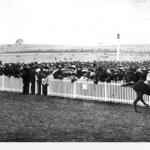

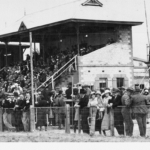
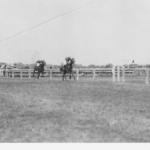
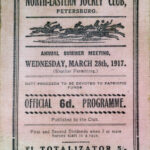
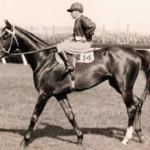

Comments
37 responses to “Horseracing”
info needed on jockeys killed while riding, reason for this, found an old grave Broken Hill cemetery, Kingsley George MacKenzie, died from injuries , horse “Gone By” Victoria Park Aug 23 1930. aged 23, errected by his Jocky friends and sporting champions (on plaque). His grave is now falling into a bit of a shame.
I think this is an area that probably needs more research Graham, we don’t have anything on file on that topic, but would love to hear more.
Hi Grahame – i know you posted this a long time ago and probably already have the answer but there was a book published in 2018 called “Their Last Ride” by John H Payne about jockeys that have died in racing and training accidents in Australia – it has the details of George’s death in the Eastwood Hurdle. He sustained fatal injuries to his abdomen when kicked by another runner while on the ground. He died on the Tuesday after the Saturday accident
Hi Just wondering if anyone could suggest anywhere I could find more information on picnic races in SA – trying to research Shackle Bar and cannot find the full 20 races he is suppose to have won. I can find 12 in a row but trying to find any other picnic race meeting run march 1949 to end of June 49
Hi Jenny, have you already tried searching on Trove? http://trove.nla.gov.au/ If you do an advanced search filtering newspapers you may turn something up.
Jenny shacklebar won 30 races ina row…according to Millers Guide which always placed it in the book…under who won most races in a row….at the time Desert Gold and Gloaming each had 19 wins in a row…Bill Edwards trained Shackle bar at Quorn…and he won his races in the country and picnics bak then..Millers Guide states that to…I worked with Bill Edwards in 1961 in Sydney..he showed me the newspaper clippings about Shackle bar…so get a millers guide ….and check it out because its there…and proves he won 30 straight….Bill told me shacklebar won 30 straight then was taken toAdelaide and got beaten a nose by Auries Star..who held the Australian 6 furlong record of 1min 8 and a quarter seconds for six furlongs ..which he did at Flemington down the straight six newmarket around 1950….shacklebar get a millers guide
I am trying to find a racing personality mainly he was a punter He was of European nationality He had A full head of white hair and very well dressed He owned buildings on Anzac highway Around kurrulta park. He would have been very well known on the racetrack Please if anyone knows his name or whereabouts This was around 1967/1980’s He would be in his late 80’s Lyn
Drawing blanks here sorry Lyn but hopefully someone visiting the site will know more. Fingers crossed.
i will see what i can find out as there still is a few racing folk around from that time frame
I believe my grandfather, William Francis Blight , was one of the first bookmakers licensed in SA. This would have been in the early 1930’s. I understand he was one of 4 bookmakers who operated at the first trots meeting at Wayville, Would you be able to help.
Hi John, I’ve had a look in our catalogues and I’m afraid we don’t have anything on your grandfather. If you click on the ‘Sources’ below the article on this web page you can see where the author, John Manion, did his research, which might be a starting point. Otherwise if you haven’t already done so I would suggest searching the newspapers on Trove: http://trove.nla.gov.au/ Best of luck with your research!
I have an old photo of jockey Stephen Clark born 1999, fell at Oakbank April 5th 1920, died april 6th 1920.
The photo had been sent to my late grandfather, but I have no idea what the connection would have been. There is no one left in the family who would know either. Do you have any information on Stephen Clark?
Hi Roma, I can’t find anything on file here. Perhaps try contacting the South Australian Jockey Club to see if they know more or have any other suggestions – http://www.sajc.com.au
Roma, I have written a 645-page book – THEIR LAST RIDE – on the almost 1000 jAustralian jockeys who have lost their lives in race-related accidents since the commencement of racing in Australia, and one of them is Stephen (Steve) Clark, who died after a fall at Onkaparinga on Cup Day, 5/4/1920. The 21-y-o died in the Adelaide Hospital, and was buried in the North Brighton cemetery, after his fiuneral cortege had left the Jetty Hotel at Glenelg. on April 8th He was born at (or near), Wolseley, on the SA/Vic border and served his apprenticeship with Mt Gambier trainer, W R Cross
Should you (or members of your family) be interested, the book, the winner of the prestigious 2020 Bill Whittaker Book Award for the best book on Australian/NZ racing to be written during the past 2-years, and the recipient of glowing testimonials, can be purchased on-line at http://www.theirlastride.com.au
Hope this info is of some help to you.
hi my Nana’s father, Harwell, was the trainer of white nose. Winner of the 1931 Melbourne cup 🙂 I vividly remember the photo on the wall. I can not find much on the web though..you tube has a video!!
Hatwell sorry not Harwell!!
Just wondering if anyone knows where I may be able to see a map of the old Thebarton course. I know roughly where it covered but would be nice to include a map. I am writing a 2nd edition of my book on Adam Lindsay Gordon, who rode at Thebarton in the 1860s.
Cheers,
Lorraine
Hi Lorraine,
Afraid I don’t know the answer to that, but if you click on ‘Sources’ above you can see where the information for this article comes from, and that may give you some leads. Best of luck with your research.
Looking for information on horse trainer AJ Cowie. My research suggests he had 3 sons (Jack and Les + Don who were twins). Jack Cowie was a champion jockey in SA who also excelled in riding stints in Victoria. I was extremely fortunate and excited to be able to purchase 2 old horse photos’s from the late 1940’s and early 1950’s. One photo is of ‘St Keyne’ winning the Wakefield Novice at Balaklava on 18/02/48, trainer was AJ Cowie, jockey was E. Whittaker. The other photo is dated 01/03/50, ‘Kayland’ winning the Stirling Novice at Strathalbyn, trainer was R. Elder, jockey was R.Kerrison. Happy to send you a copy of this if required. Struggling to find any/much information about either the trainers or jockeys. Would appreciate any assistance or information about these horses/trainers/photo’s. Thanks in advance……Robert
Hi Robert, I’m afraid we don’t have anything further on file here. I will forward your comment to John Mannion, author of this article, to see if he has any suggestions. You can see where John found his information if you click on ‘Sources’ below the article. this may give you some leads to follow up.
Robert jack cowie was apprenticed to his dad his twin bros were with my uncle ben matson and would wag school on Wednesdays to ride at midweek meetings ross elder was a jumps jockey who helped my uncle fred matson rex kerrison was apprenticed to fred regards ken matson
atRobert ferwerdas post jack cowie came from broken hill 14 yrs of age at 18 he worked for ben matson at semaphore park some of his many wins was on the top filly minion his twin bros les and don were apprenticed to ben matson and would often wag school of a Wednesday to ride ross elder was a top jumps rider who helped fred matson rex kerrison was freds apprentice regards ken matson
Thanks for sharing that information Ken. It sounds like an interesting career!
Can anyone help me with when and how the Labour Day Cup started in South Australia. I have noticed that it is snot run anymore, when did it end.
Hi Franc,
I don’t know the answer to that immediately but will get back to you if we’re able to find anything out.
Hi Graham
Yes, it’s a crying shame to see so many of the graves of fallen jockeys so neglected. As I explained to Roma, I have written an Award-winning book of 645 pages – THEIR LAST RIDE – on th almost 1000 Australian jockeys who have lost their lives in race-related accidents since 1810, and besides including the first rider killed in SA, (and only the 2nd in Aust) – John Bullen – who the SAJC, along with about a dozen other riders, has neglected to include on their monument to the fallen of SA at Morphettville (and incidentally, his fatal fall occured very near to where that monument is located!), the book also includes a brief summary of McKENZIE (who I have as George Kingsley McKenzie), who was killed in Adelaide, shortly after relocating there from Broken Hill, where his body was returned for burial by his siblings, his mother and father having supposedly pre-deceased him.
Should you be interested, the popular book can be brought on-line at http://www.theirlastride.com.au McKenzie actually died a few days after his fall, at the Adelaide Hospital – on Tuesday August 25th – following a blood transfusion – Trust this is of some assistance Graham
Hi John I am very interested in the information you have on Kingsley Mackenzie ( he is my great, great uncle). I was just wondering where you got your information from? The story we received from Kingsley’s younger brother Jack was that he died on the field. Would love to know more of the story.
Thanks Kandice.
Does anyone remember a jockey by the name of Brian Freudiger ??
Perhaps try the South Australian Jockey Club, http://www.sajc.com.au
Hope that helps Angela.
Hi, I am doing an assignment and would like as much information on the Kadina / Wallaroo Racecourse and the grandstands. Thank you
Hi Ellise – all the information that we have is here on the website. If you click on the ‘Sources’ tab above the comments you will see what the authors used for their research which might give you an idea of where else to look.
Dear Catherine I am a photo curator/historian seeking to identify a horse and jockey with two gents in a paddock it is carte de visite by commercial photographer
Saul Solomon of 51 Rundle st active at that address in Adelaide 1874-91
Is there a historian anywhere with knowledge of SA racing in these years. Happy to send an image. regards Gael Newton
Hi Gael,
I can pass on your details to John Mannion who wrote this piece. If he does not know then he may be able to put you in touch with someone else. We’d love to see the photo also and I’ll see if any of my colleagues at the History Trust can help.
Looking for information about my father ROSS FRANCIS TURNER.
He was a harness driver in the 60’s.
I have not got any information from my mother, who passed 5 years ago. It was a tragic passing in 1965, just after I was born.
If you have any photos or information regarding friends still alive…I would be so appreciative.
I wait for your reply.
Hi Tracey, I’ve searched our catalogues and it doesn’t look like we have anything on file. If you’re looking specifically for photographs the State Library collection is a good place to start – https://www.catalog.slsa.sa.gov.au/ and for information on racing history you could also try contacting the South Australian Jockey Club – https://www.catalog.slsa.sa.gov.au/ Best of luck with your research!
Hi,
I can’t find photos anywhere, but was there a horse/harness-racing track at Klemzig in the ’90s, where the Klemzig/Gaza football oval and recreation park are now? I swear I haven’t made it up, but I can’t find anyone else who remembers it.
Thanks!
HI Carys,
I’ve had a bit of a dig and so far only turned up references to greyhound racing. That’s not to say that there wasn’t a horse racing track, just that I haven’t been able to find any reference to one as yet.